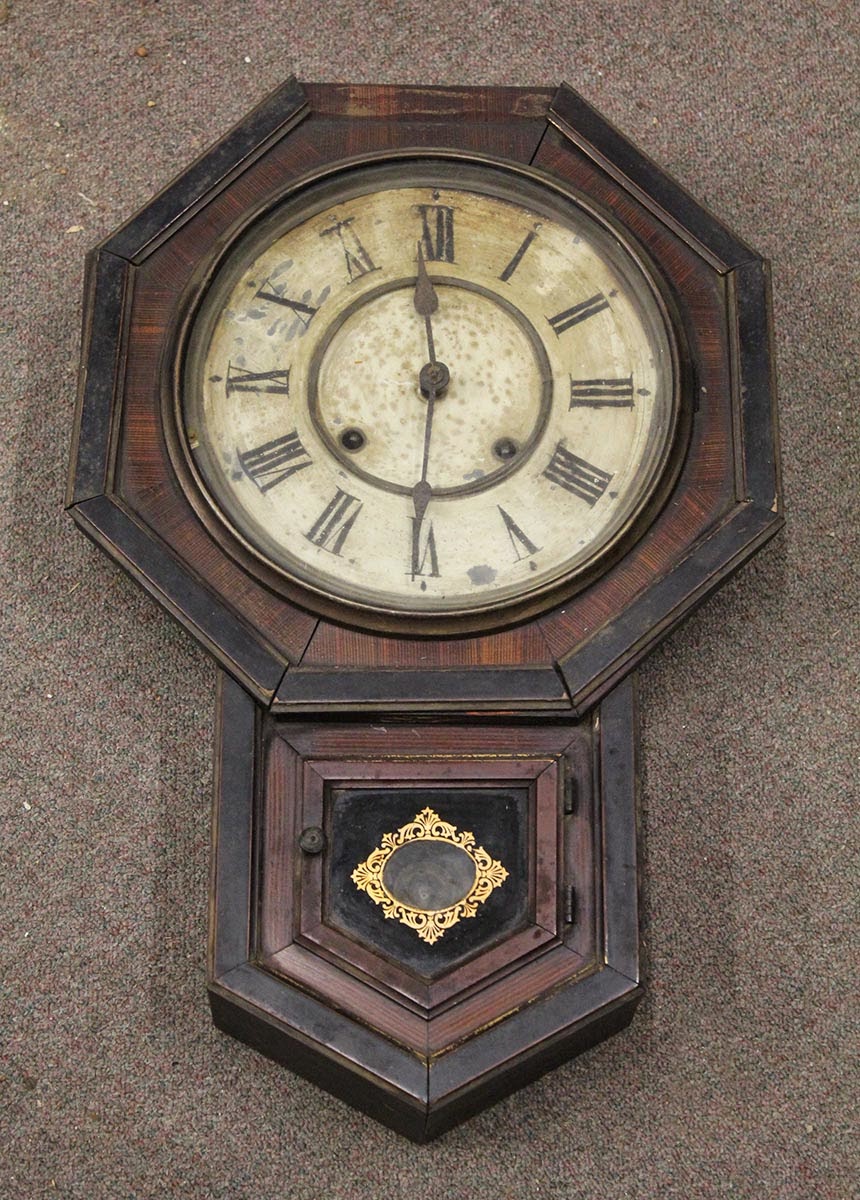Now, time for more clocks! I've selected a few international wall clocks for this post.
England
 |
| Rombach wall clock |
Thomas Rombach was a Bermondsey clockmaker, as the address boldly written across the dial indicates. Prior to 1891, he was in partnership with Adreas Saum at 215 Grange Road.
 |
| Detail of dial, showing some damage to the paint. |
The label inside the case, T. Rombach, Practical Watch and Clock Maker and Jeweller, lists some of his services, including clock winding and payment plans. If I'm remembering correctly, the type of "clubs held" were buying clubs, to make it easier for consumers to buy expensive items.
The label also indicates that Rombach was servicing this clock until 1939.
Germany
Next up is a regulator from Germany. I didn't have anyone with me to hold it up, so this isn't the most flattering photograph. As you can see, there are a couple pieces near the top of the case that need to be reattached. Otherwise, though, the case is in good shape.
How do I know it's German? Well, I'm going by the letters D.R.C.M. found on the bracket holding the movement in place; except that the letters are almost certainly D.R.G.M., which was a type of patent mark used in Germany starting in 1891 ("Deutsche Reichsgebrauchsmuster"). A Gebrauchsmuster was a utility model (rather than a patent model) protecting the design or function of of an item.
One of the fun things about the internet is how easy it is to find information. Photos of a similar clock were posted in a NAWCC discussion thread. I didn't have time to take apart this clock to look for the maker's mark, but I'm going to assume from the similarities to the clock in the discussion thread, and others, that it is the same. Which means that it was made by Thomas Haller A.G. sometime around 1910.
Thomas Ernst Haller (1878-1954) came from a watchmaking family. His father, Thomas Haller (1854-1917) established his own business in the 1880s, producing pocket watches and clocks. Thomas Ernst succeeded his father in operating the Haller A.G. company.
In 1900, Haller merged with Uhrenfabriken Gebrüder Junghans. The merger lasted several years before being dissolved.
Haller A.G. was acquired by Kienzle in 1929.
 |
| Case interior, with Roman numeral markings on the lower right. |
 |
| Front and back of the pendulum bob, showing a surprising amount of messy metalwork. |
Japan
The third clock for this post was made by Aichi Clocks. Aichi was founded in 1892 or 1898 at Nagoya, Japan. A description of the 1903 National Industrial exhibition held at Osaka noted that Aichi Clock Company employed some 300 workers, and that there were twelve companies in the Aichi Clock Manufacturers' Guild.
Aichi produced inexpensive Western-style clocks for export. The production numbers for 1918-19 show that China was their largest export market, followed by India, the Philippines, Great Britain, Peru, and elsewhere. The United States was presumably lumped into the category of "Other countries," to which they shipped a total of 673 clocks in that year. Meanwhile, the U.S. was shipping steel springs and other supplies to Aichi.
During the early 1900s, Aichi manufactured precision equipment for the Japanese military. They became an aircraft manufacturer during the 1920s and were the fourth-largest aircraft supplier for the Japanese military during World War II. Later, after the war, they produced gears for motorcycles.
 |
| Aichi Clocks 8-day octagon regulator |
 |
| The oddly-discolored paper label inside the clock. |
 |
| The paper label on the back of the clock. Can anyone translate this for me? |
Japan's Aichi prefecture is currently home to Naluse Company, which claims to be the only Japanese company making Japanese clocks (as opposed to Western-style clocks).
Germany?
These last two clocks are still a mystery for me. My inclination is to think they are German, but I could be completely wrong about that. [UPDATE 4/4/14: a friend of my father's has suggested that they are Black Forest clocks; after a quick search online, I have to agree.] American manufacturers produced clocks like these, but they usually stuck their name somewhere prominent on the front or back. Think about that for a moment: we take it for granted that the maker's name will appear on the face of a clock or watch, boldly turning the timepiece into an advertising poster. The Rombach at the start of this post is an excessive example, in which he's even plastered his address on the dial. We've acclimated to the hubris, but in other cultures and in other eras, it would have been considered tacky and vain to have the maker's name on the dial.
Anyway, here are the two mystery clocks. They appear to have been made by the same company. Decorative painted porcelain fronts are attached to plain wood boxes designed to hold the movements and allow you to mount the clock on the wall. Weights are not currently attached; I have three buckets full of clock weights, so I'm sure they're here somewhere.
The movement is accessed through hinged doors on either side of the clock.
The back has a hole for mounting to the wall, and what appears to be the maker's name.
I've tried to decipher the name, but so far I haven't had any luck figuring it out.









I blog often and I genuinely thank you for your information. This article has really peaked my interest.
ReplyDeleteI will take a note of your blog and keep checking for new details about once
per week. I subscribed to your RSS feed as well.